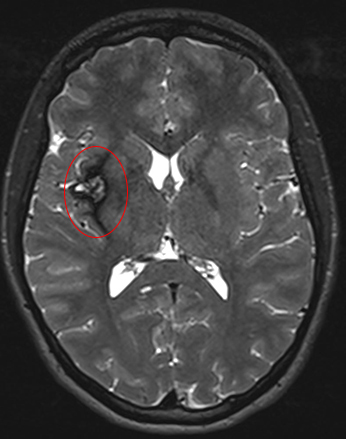Cavernomas are enlarged and deformed blood vessels gathered into clusters. These clusters, called angiomas, may look bubbly, like raspberries. A cavernoma can appear in the brain, spinal cord or other parts of the nervous system and body, including on the skin and eye.
Cavernomas can cause:
- Leaking blood
- Arm or leg weakness
- Damaged vision, balance, memory, or attention
- Stroke in younger people
Cavernoma Center of Excellence
We're recognized as a Center of Excellence by the Angioma Alliance - one of only eight around the country, and the only one found in the Southeast region.
We've received this designation not only because of the high-quality care delivered by our dedicated team. Centers of Excellence also research new technologies and techniques for treating cavernomas.
Types of Cavernomas
Cavernomas come in two forms:
- Sporadic — most common; when only one cavernoma develops, and the condition doesn’t run in your family
- Familial — less common; more than one cavernoma occurs and the condition runs in your family
Other terms used for this condition includes cerebral cavernous malformations (CCMs), cavernous angiomas, or cavernous hemangiomas.
Enlarged Blood Vessel Clusters in the Brain
Cerebral cavernous malformations, or CCMs, are abnormal blood vessels that gather into clusters about the size of a raspberry. View cavernoma transcript.
Cavernoma Treatment at UVA
Our treatment team includes neurologists, neurosurgeons, skin specialists, imaging specialists, and genetic counselors. Together, we develop a strategy to address your cavernoma symptoms.
Treating a Cavernoma
Cavernomas are diagnosed using magnetic resonance imaging (MRI). Treatment for cavernomas includes:
- Medication — If you are having seizures, you may be given medications to stop them.
- Surgery — You may need surgery to remove your cavernoma if you're experiencing symptoms.
- Genetic testing and counseling — If cavernomas run in your family, we may be able to identify the affected genes. We may also be able to determine if you have family members with the affected gene.
Most cavernomas do not need surgery. If you aren’t having symptoms, your healthcare provider will use MRI to monitor for any changes in your cavernoma.
How Do I Know if I Have a Cavernoma?
Usually, you won’t know until the cavernoma causes a seizure. Sometimes they are found when you get brain imaging for other reasons. Symptoms generally appear when cavernomas bleed, and they may include:
- Seizure
- Sudden headache
- Nausea and/or vomiting
- Weakness or numbness on one side of the body
- Difficulty speaking or understanding speech
- Double vision or loss of vision
- Balance problems
Cavernomas on the skin are often seen in cases of familial cavernoma. They usually appear on your arms or legs, and have the same bubbly, berry-like appearance.
What Should I Bring to My Appointment?
For your first appointment, you should bring any previous brain imaging, like MRIs or CT scans, with you.
If you can, you should also ask your biological parent(s) the following questions, and bring the answers with you:
- Have you been diagnosed with a cavernoma?
- Have you ever had seizures?
- Have you ever had a stroke?
- Do you have a history of headaches?
- Do you have siblings (brothers and sisters)? If so, do they have a history of seizures, headaches or strokes?
- Do you know where your ancestors came from?
Patient Resources
Check out the Angioma Alliance for more information and resources about both sporadic and familial cavernomas.

